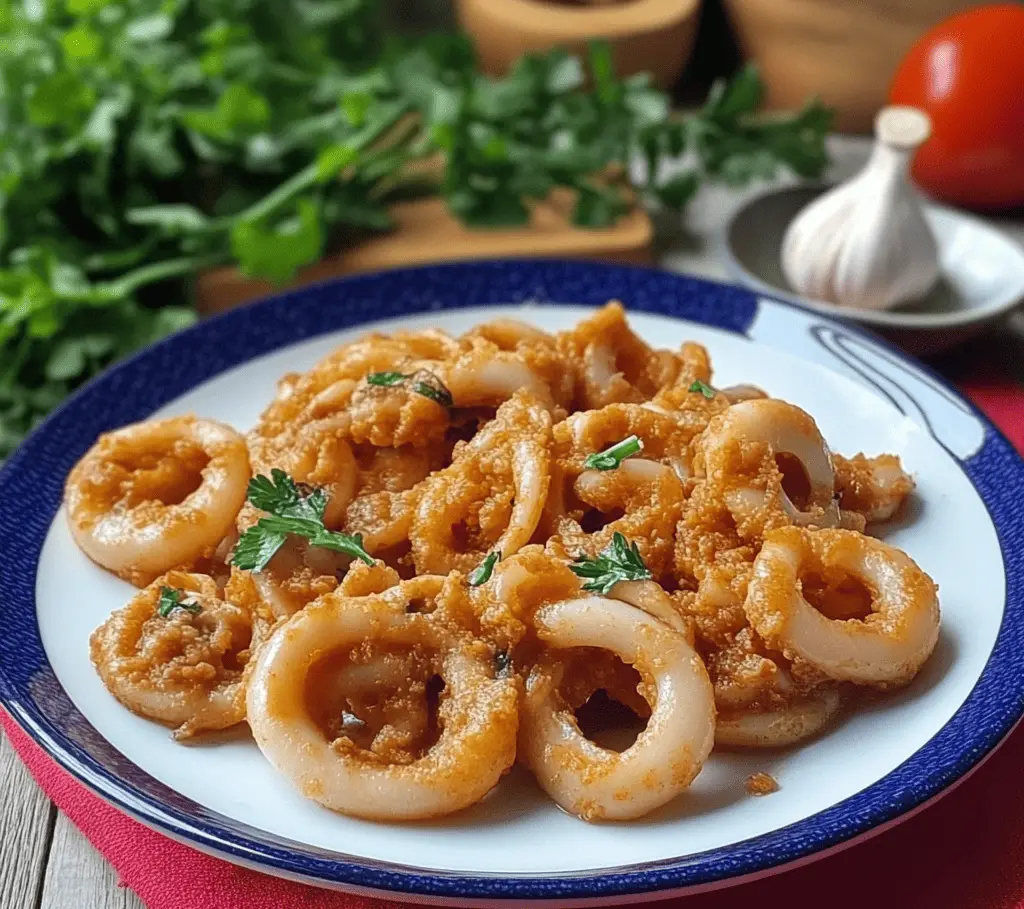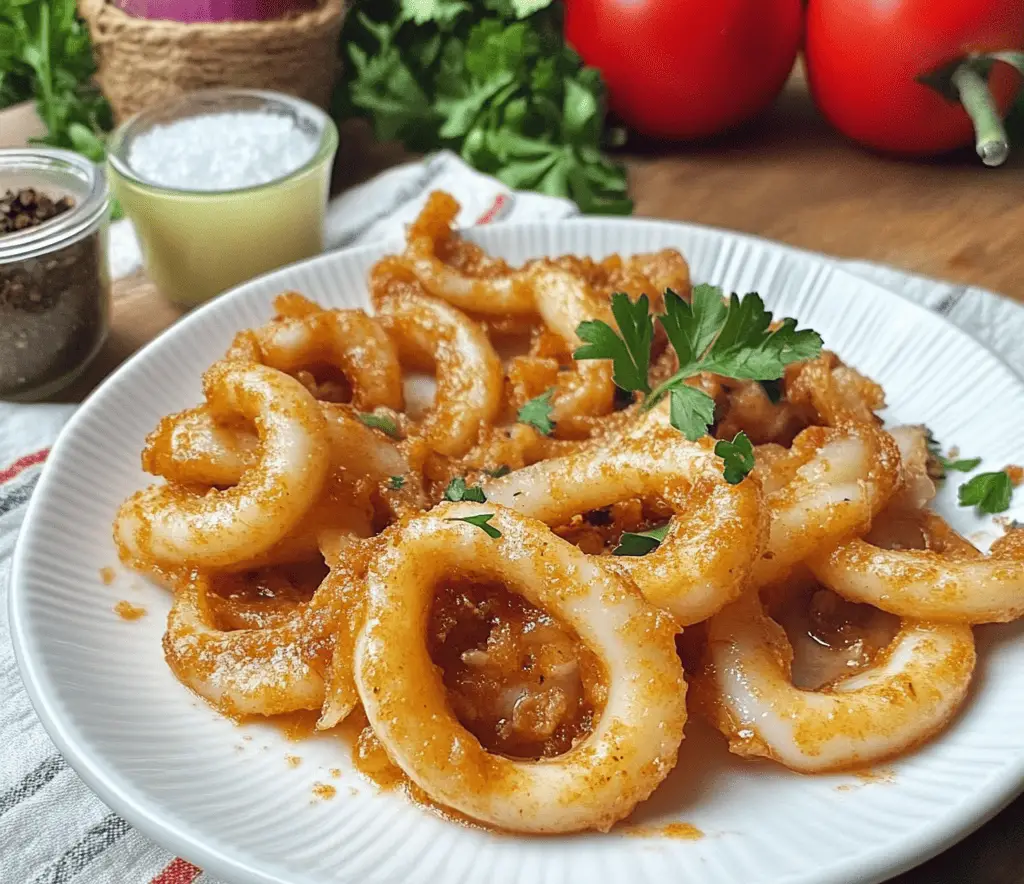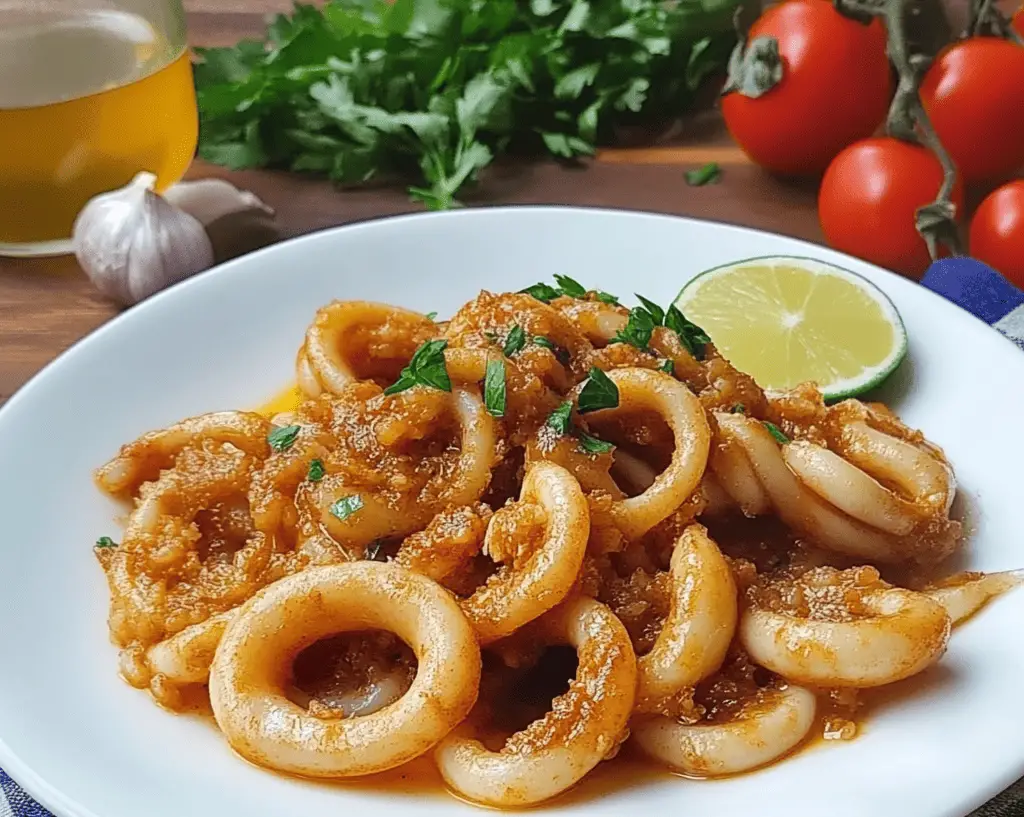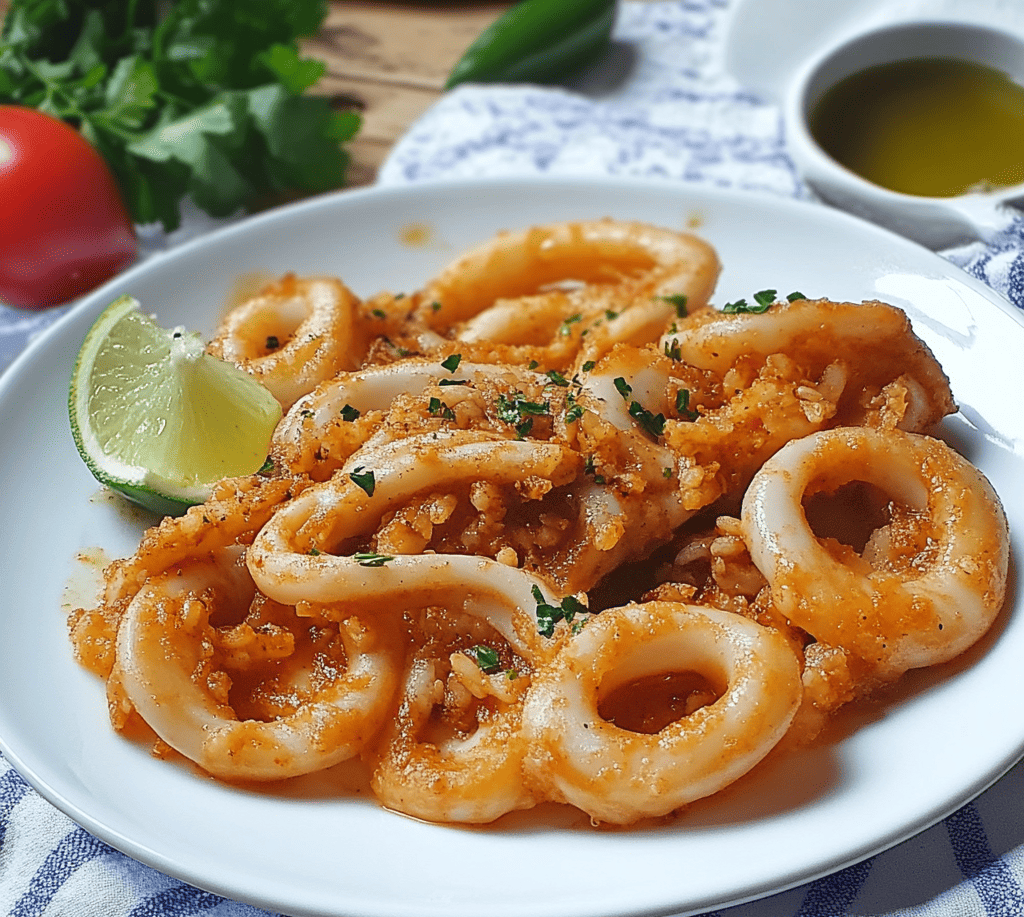Calamari in American Sauce: A Seafaring Classic Full of Flavor
Introduction
Calamari in American sauce is an iconic dish of Mediterranean cuisine, especially popular in Spain and Portugal, encapsulating the essence of the flavors of both land and sea. This comforting and aromatic stew combines the tender texture of squid with a rich and complex sauce, traditionally containing tomato, onion, garlic, peppers, and a touch of brandy or white wine. The result is a versatile dish, perfect as an appetizer, tapa, or main course, often served with white rice to soak up every drop of the delicious sauce. It’s a recipe that, although it requires some time to cook, rewards with a deep flavor and a culinary experience that evokes the sea breeze and tradition.
Detailed History
The story of calamari in American sauce is a fascinating journey through coastal cuisines and the evolution of ingredients.
Squid in Gastronomy: Squid, a cephalopod mollusk, has been a food source for coastal communities since ancient times. Its tender flesh and mild flavor made it popular in the diets of Mediterranean civilizations. In Spanish cuisine, squid is a fundamental ingredient, present in a multitude of preparations ranging from the popular Roman-style calamares (battered and fried) to more elaborate stews like this one. Its versatility and abundance along the Spanish and Portuguese coasts have cemented it as a pillar of seafood cuisine.
The Origin of “American Sauce”: The name “American sauce” can be misleading, as it does not originate in the Americas, but rather in French cuisine, and is closely associated with seafood. It is believed to have been named after a French chef, Pierre Fraisse, who worked at a restaurant called “Américain” in Paris in the 19th century. Fraisse, originally from Provence, created this sauce to accompany lobster and other seafood. The sauce was characterized as a base of sautéed vegetables (onion, carrot, sometimes bell pepper), tomato, garlic, herbs, and, crucially, a liqueur, typically brandy or cognac, which was flambéed to add depth of flavor. Often, shellfish shells were used to make a fumet that further enriched the sauce.
Over time, this sauce traveled from France to Spain, where it was adopted and adapted by the local cuisine. Spanish chefs found it perfect for enhancing the flavor of local seafood and fish, including squid. The recipe evolved to include more accessible and common ingredients in the Spanish pantry, such as green peppers, and established itself as a robust and flavorful sauce, ideal for slow-cooked stews that allow the flavors to blend and deepen.
Seafood Stew: Seafood stews are a culinary tradition rooted in many coastal cultures. In Spain, “guisos marineros” or “guisos en salsa” (seafood stews) are common, allowing seafood to cook slowly in an aromatic base, absorbing all the flavors. Squid is particularly well-suited to this type of cooking, as it requires extended simmering to soften and become tender, unlike rapid cooking, which makes it rubbery.
Thus, squid in American sauce is the result of a fusion of traditions: the ancestral use of squid as food, the sophistication of a French sauce, and the adaptation to Spanish home cooking, creating a dish that is both elegant and comforting.
More Historical Detail
The original French “American sauce” was a more refined sauce and was often served with luxury seafood like lobster, which was cooked directly in the sauce or glazed with it. The Spanish version, while maintaining the essence of the base ingredients (sofrito, tomato, liqueur), tended to be simplified and adapted to become a more rustic and hearty sauce, ideal for stewing. In many homes, leftover seafood was used to create base broths, which added an unparalleled umami to the sauce.
The addition of green pepper, for example, is very characteristic of Spanish cuisine and adds a fresh, slightly spicy note to the sofrito. The use of brandy or cognac for flambéing is key, as the alcohol evaporates, leaving behind only the aromas and depth of flavor, slightly caramelizing the sofrito’s natural sugars. This flambéing technique is a direct legacy of French haute cuisine and has been incorporated into more home-style dishes.
Over the years, the recipe has been passed down from generation to generation, with each family adding their own personal touch, whether it’s a pinch of sweet or hot paprika, a bay leaf, or a bit of homemade fish stock to intensify the flavor of the sea.

Ingredients
To prepare this delicious seafood delicacy, you will need:
- Fresh or frozen squid (approximately 1 kg, cleaned and cut into rings and tentacles)
- 1 large onion, finely chopped
- 1 green Italian or bell pepper, chopped
- 2-3 cloves of garlic, minced or sliced
- 400g of crushed or grated natural tomatoes (or a can of whole peeled, crushed tomatoes)
- 3-4 tablespoons of extra virgin olive oil
- 1 bay leaf (optional)
- Salt to taste
- Freshly ground black pepper to taste
- Chopped fresh parsley (for garnish)
- Cooked white rice (to accompany)
Detailed Preparation
Follow these steps carefully to achieve tender squid and an irresistible sauce:
Step 1: Cleaning and Cutting the Squid
- If using fresh squid, clean it thoroughly. Remove the transparent pen (or “squid quill”), the viscera, the outer skin (if you prefer, although it’s edible), and the eyes. Separate the tentacles and the body.
- Cut the body into rings about 1-2 cm thick. Leave the tentacles whole or cut them off if they’re too large.
- Wash the rings and tentacles thoroughly under cold water. Drain thoroughly and pat dry with kitchen paper. This is important so they brown well in the sauce and don’t release too much water at once.
Step 2: Preparing the Base Sofrito
- In a large, heavy-bottomed saucepan (ideally a clay pot or low cast iron pot) or deep skillet, heat the extra virgin olive oil over medium heat.
- Add the chopped onion and sauté over medium-low heat for 8-10 minutes, or until translucent and well-sautéed, but not overly browned. The key to a good sauce is slow sautéing.
- Add the chopped green bell pepper and the chopped or sliced garlic. Cook for another 5-7 minutes, stirring occasionally, until the bell pepper is tender and the garlic is fragrant.
Step 3: Adding the Squid
- Increase the heat to medium-high. Add the cleaned and dried squid to the pot. Stir and cook for 3-5 minutes, or until the squid changes color and releases some of its liquid. At first, the squid will shrink and become firmer.
Step 4: Add the Tomato and Slow Cook
- Add the crushed or grated tomatoes to the casserole. Add the bay leaf (if using), salt, and freshly ground black pepper to taste.
- Stir all ingredients well to combine.
- Bring the sauce to a gentle boil, then reduce the heat to low, cover the pan with a lid, and let it simmer for at least 45 minutes to 1 hour and 30 minutes.
- Cooking time will depend on the size and tenderness of the squid. Cook until very tender (some squid need more time than others). Stir occasionally to prevent it from sticking to the bottom and to check the tenderness. If the sauce becomes too dry, you can add a little fish stock or hot water.
Step 5: Final Adjustment and Serving
- Once the squid is tender and the sauce has thickened and concentrated its flavor, taste and adjust the salt and pepper if necessary.
- Remove the bay leaf before serving.
- Serve the squid in American sauce piping hot, accompanied by loose white rice to absorb the delicious sauce.
- Sprinkle generously with chopped fresh parsley just before serving for a touch of color and freshness.
Estimated Preparation Time
- Active preparation time (cleaning and cutting): 15-20 minutes
- Cooking time for sofrito: 15-17 minutes
- Cooking time for squid in sauce: 45 minutes – 1 hour and 30 minutes (depending on the tenderness of the squid)
- Estimated total time: Approximately 1 hour 15 minutes to 2 hours (not including the cooking time for the rice, which can be done in parallel).
Additional Tips
- Squid: To ensure tenderness, avoid cooking the squid over high heat throughout the stew. Large squid will require more cooking time. Some people prefer to use small squid (baby cuttlefish) for faster cooking and a different texture.
- Sofrito: The foundation of a good sauce is a well-made sofrito. Take your time to sauté the vegetables over low heat; this will release all their sugars and flavors.
- Brandy/Wine: Alcohol is important for depth of flavor, but if you prefer not to use it, you can omit it or substitute it with a little fish stock or a splash of sherry vinegar for a touch of acidity.
- Tomato Intensity: If the tomato is very acidic, you can add a pinch of sugar to the sauce to balance the flavor.
- Thickening the Sauce: If the sauce is too thin, you can increase the heat and simmer uncovered for a few minutes to reduce it. If it’s too thick, add a little fish stock or water.
- Accompaniment: Although white rice is the classic, these squid are also delicious with boiled or fried potatoes, or even some good bread to dip in the sauce.
- Rest: Like many stews, the flavor of calamari in American sauce improves the next day. If possible, prepare it in advance and reheat gently.

Questions and Answers
How do I know if the squid is tender? Pierce a piece of squid with a fork; if it goes in without resistance, it’s ready. If it feels chewy, it needs more time to simmer.
Can I use canned tomato paste instead of crushed or grated tomato paste? Yes, you can use tomato paste, but adjust the quantity, as it tends to be more concentrated and sweeter. Choose natural crushed or grated tomato paste for a fresher, less processed flavor.
What type of white wine is best? A dry, light white wine, such as Verdejo, Albariño, or Sauvignon Blanc, will work well. Avoid sweet or highly aromatic wines.
Can I make a spicy version? Absolutely. You can add a small, chopped chili pepper to the sofrito along with the garlic, or a pinch of hot paprika.
Can this dish be frozen? Yes, calamari in American sauce freezes very well. Let it cool completely, then store it in a freezer-safe, airtight container for up to 3 months. To thaw, transfer it to the refrigerator the night before and reheat gently in a casserole dish.
Texture and Flavor
This dish is a feast for the palate due to its rich combination of textures and flavors:
- Texture: Calamari, when cooked correctly, is tender and slightly chewy , almost melting in the mouth—a far cry from the rubbery texture often associated with undercooked squid. The sauce is thick, creamy, and velvety , with the onion and pepper bits softened to a melting point, adding body. The white rice, when served, is loose and fluffy , perfect for soaking up the sauce.
- Flavor: The flavor is deep, umami, and slightly sweet , with a masterful balance of sea and land elements. The base is the natural sweetness of caramelized onion and tomato , complemented by the subtle aroma of garlic and the freshness of green pepper . The marine flavor of the squid is intensified and blends with the sauce. A touch of brandy or wine brings aromatic complexity and a light, toasted sweetness. Salt and pepper enhance all the flavors, and the bay leaf adds a classic herbaceous touch. It’s a comforting flavor that transports you to Mediterranean home cooking.
Consumer Context
Calamari in American sauce is a versatile dish that adapts to various occasions:
- Main Course: Served with white rice, this is a hearty and delicious main course, ideal for a family dinner or a weekend meal.
- Tapa or Appetizer: In smaller portions, this can be an excellent tapa at a bar or an informal gathering, served in individual casseroles with bread for dipping.
- Homemade Comfort Food: This is the kind of stew you enjoy at home, especially on cold days or when you’re looking for a dish that “feeds the soul.”
- Informal Gatherings: Although it’s a dish that requires cooking, it’s not overly complicated, making it suitable for when you’re having guests but want something that simmers while you take care of other things.
- Pairing: Pairs well with dry white wines with a certain structure, such as a good Albariño, a Godello, or even a Chardonnay with a moderate oak age. Light, crisp lagers are also a good choice.
Visual Aspect
The dish of squid in American sauce is visually appetizing and comforting:
- Sauce Color: The sauce has a deep reddish color, ranging from orange to dark red, indicating the presence of well-cooked and concentrated tomato. It’s a warm and appetizing color.
- Shiny Calamari: The squid rings and tentacles, a creamy white before cooking, become more opaque and coated with sauce, but their characteristic shape is visible, with a subtle sheen from the oil.
- Sauce Texture: The sauce appears thick and smooth, with small pieces of vegetables that have been simmered, suggesting a rich, dense texture.
- Rice Side Dish: Fluffy, well-cooked white rice serves as a neutral canvas that contrasts with the vibrant color of the squid in sauce. It’s often presented in a mound or in a pale portion alongside the stew.
- Touch of Freshness: Freshly chopped parsley sprinkled on top adds a vibrant touch of green, contrasting with the reddish and white tones, providing visual freshness.
- Appetizing Presentation: The dish looks hearty and satisfying, inviting you to immerse yourself in the richness of its flavors.
Overall, the visual aspect is that of a homemade, authentic and delicious dish.
Curiosities
- Low Calorie Squid: Squid itself is a low-calorie, protein-rich seafood, making it a healthy choice. The calorie density of the dish comes primarily from the oil and ingredients in the sauce.
- Squid Ink: In some recipes, especially in Basque cuisine, squid ink is added to the sauce, giving it a deep black color and an even deeper, saltier flavor. However, it is not part of the traditional “American sauce” recipe.
- Cooking Squid: The key to tender squid is to cook it either very briefly (a minute or two) or very long (more than 30-45 minutes). Anything in between will make it rubbery. In this stew, slow cooking is the strategy.
- Regional Variations: In Spain, there are many variations of squid stews, each region with its own twist. Some use a more spicy sofrito, others add potatoes or peas.
- Natural Umami: Squid and tomato, combined with a good sofrito and a touch of alcohol, are ingredients rich in umami, which contributes to the depth of flavor of the dish.
Nutritional Value (estimated per serving)
The exact nutritional value of calamari in American sauce can vary considerably depending on the amount of oil used, the serving size, and whether it’s served with or without rice. The following is a rough estimate for 4 servings (excluding rice, as it varies greatly):
Estimated serving (1/4 of the recipe, without rice):
- Calories: 250-350 kcal
- Total Fat: 15-25 g
- Saturated Fat: 2-4 g
- Cholesterol: 200-300 mg (squid is high in dietary cholesterol)
- Sodium: 400-600 mg (depending on added salt and broth if used)
- Total Carbohydrates: 10-15 g
- Sugars: 5-8 g (from vegetables and alcohol)
- Fiber: 2-3 g
- Protein: 25-35 g
Considerations:
- Cholesterol: Squid is known for its cholesterol content. However, studies have shown that dietary cholesterol has less impact on blood cholesterol levels than previously thought.
- Proteins: It is an excellent source of lean proteins.
- Vitamins and Minerals: Provides B vitamins, iodine, selenium, and other minerals. The vegetables in the sauce also contribute vitamins and antioxidants.
- Fiber: Vegetables provide dietary fiber.
This dish is a nutritious option, especially due to its high protein content.
Additional Benefits and Interesting Facts
- High Protein Content: Squid is an excellent source of high-quality protein, essential for building and repairing muscle tissue.
- Rich in Minerals: Contains important minerals such as selenium (an antioxidant), iodine (essential for thyroid function) and phosphorus.
- Low in Fat (squid): Squid itself is a lean seafood.
- Umami Flavor: The combination of tomato, onion, garlic, and squid creates an umami-rich flavor profile, making it very satisfying.
- Culinary Tradition: Preparing this dish is a way to connect with the rich Mediterranean and Spanish culinary tradition.
- Ideal for Batch Cooking: Since its flavor improves with age, it is an excellent dish to prepare in large quantities and enjoy for several days.
Other Information
- Variations: You can experiment with adding fresh or frozen peas in the last 10-15 minutes of cooking to add sweetness and color. Some recipes include diced potatoes to cook in the sauce.
- Spicy: If you like spicy food, a pinch of cayenne or dried chili in the sofrito will give it a special touch.
- Freezing: When freezing, it’s best to do so in individual portions to facilitate thawing. Make sure the container is freezer-safe and allow room for expansion.
- Serve hot: This dish is best enjoyed hot, as the sauce and squid retain their optimal texture and flavor.

Conclusion
Calamari in American sauce is a dish that embodies the essence of home-style seafood cooking: robust flavors, tender textures, and an aroma that evokes tradition. From its roots in French haute cuisine to its adaptation in Mediterranean homes, this stew is a testament to the richness and versatility of seafood ingredients. Its preparation, although requiring patience for slow cooking, is rewarding, and the end result is a dish that delights the senses and satisfies the soul. Whether as a main course at a family meal or as a delicious tapa at a get-together, calamari in American sauce is a sure choice that guarantees a culinary journey full of flavor and tradition. Go ahead and try it and enjoy this timeless classic!

